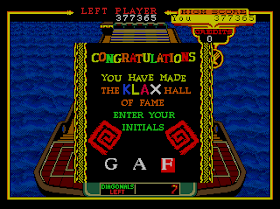While in the US, where it was Tengen's one and only release on the TurboGrafx-16, the legal credits were slightly simpler:
KLAX was one of the many action puzzle games that followed in the successful footsteps of TETRIS, but to the credit of Atari Games designers Dave Akers and Mark Pierce, it's a different and more intense experience.
The player has a small collection of 25 slots to work with, and must stack colored tiles to create horizontal, vertical and diagonal rows of matching tiles. The player must actively catch and flip the incoming tiles into place -- no just letting them fall, as there's a drop meter and too many fumbles result in a lost credit. We can also accelerate the movement of the tiles to speed up play when we think we can take it, and we can stack the tiles in last-in-first-out order on the "catcher" to make adjustments on the fly, up to a point. Scores correspond to the difficulty of the row formed -- verticals are easy, as we can just dump the tiles into the same column; horizontals are more difficult as we have to plan ahead a bit; and diagonals are the most difficult, especially when we have to form a number of them in a Diagonal Wave.
The Japanese version is largely in English, but the key instructions are presented in Japanese:
KLAX was simple enough in concept that it was ported to most of the platforms viable at the time, including the aging Atari 2600, the Game Boy (two different versions, both using patterns instead of colors), the Atari Lynx and the NES among many others. The PC Engine/TurboGrafx version is one of the closest to the arcade -- the digitized audio doesn't sound as clean and the effects sound like they were re-recorded, but the look and feel of the game are pretty spot-on. The voice that announces each wave is slightly higher-pitched than in the original arcade version, and the end-of-wave applause is augmented by cheering gentlemen in the background, making both sound effects sound slightly more Japanese. After we've exhausted our three credits, the game even retains its original ADD COINS display, even though we have absolutely no way to do so:
The Japanese version retains the Western alphabet for entering the initials on the high score board, so our old friend Alphonse S. Snodgrass can still put in an appearance if we want to rock the arcade 80s style.
KLAX holds up remarkably well two decades on -- it has a stronger sense of risk and reward than the comparatively sedate TETRIS, and while it hasn't survived nearly as long as its presumable inspiration, it's still good for a quick round every once in a while. Maybe the fact it hasn't been updated to death as KLAX Party or KLAXORAMA means Atari got it right the first time.
This one's not hard to find in either territory, and for a near-arcade-perfect experience I would recommend picking up the coin-op version in one of the Midway / Atari / Williams collections where it has turned up in recent years. But if you're looking for the PC Engine edition, it might be available here.






No comments:
Post a Comment